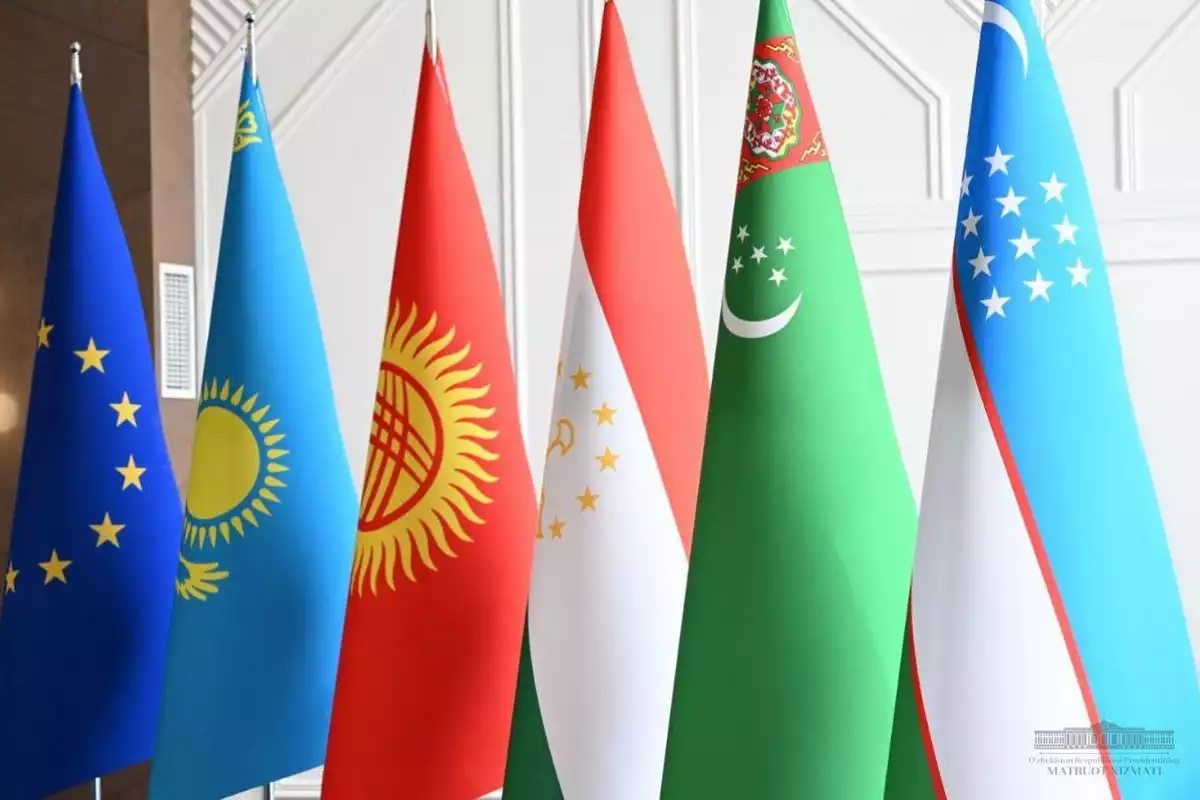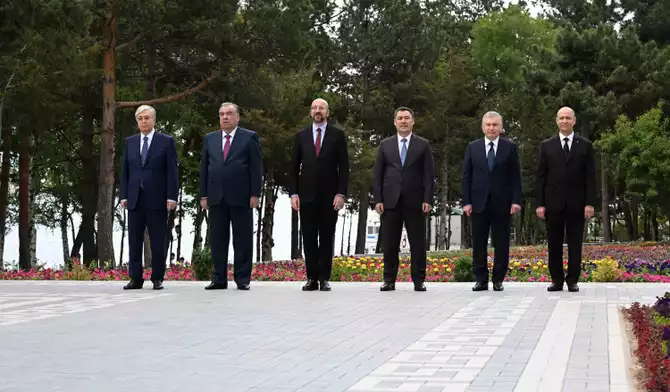
Photo: Uzbekistan's presidential press service
Samarkand will host the European Union - Central Asia summit on April 3-4, marking a significant step in strengthening the partnership between the two regions. For the first time, the summit will bring together Central Asian leaders, European Commission President Ursula von der Leyen, and European Council President António Costa.
Beyond bilateral meetings and the plenary session of the summit, the program also features an international climate forum on April 4, The Caspian Post reports citing Kazakh media.
For EU officials in Brussels, the summit marks a landmark moment and builds on years of deepening engagement and a shared desire for stronger strategic ties. It may also signal a commitment to launch a formal EU-Central Asia strategic partnership.
“At the summit, we will deepen trade ties and expand cooperation in transport, critical raw materials, digital connectivity, water, and energy. All of this will be backed by a new Global Gateway investment package, turning our commitment into action,” she said.
Several high-level engagements preceded the summit, including a recent ministerial meeting in Ashgabat with High Representative for Foreign Affairs and Security Policy and Vice-President of the European Commission Kaja Kallas. Before that, EU Commissioner for International Partnerships Josef Sikela toured Central Asia, advancing Global Gateway goals in the region.
What’s on the agenda
Talks aimed at strengthening EU-Central Asia bilateral ties will center on shared priorities such as multilateralism, security, trade and investment, environmental and climate issues, energy and connectivity through the Global Gateway initiative, as well as fostering people-to-people exchanges.
Trade and investment will be key on the summit agenda, with a focus on transport, critical raw materials, digital connectivity, water and energy.
The EU remains one of the key trade and investment partners of Central Asia. Data from the EU Commission indicates that the EU accounts for 22.6% of the region’s combined foreign trade as of 2023. Over 40% of investments in the region come from the EU.

EU and Central Asian leaders pose for a group photo at the Cholpon-Ata meeting in July 2023. Photo credit: akorda.kz
Transport and connectivity have been a cornerstone of the partnership, with the EU committed to mobilizing 10 billion euros (US$10.8 billion) from international financial institutions for the development of the Trans-Caspian International Transport Route (TITR).
Critical raw materials will be a key focus of the summit agenda, with plans to endorse a joint declaration of intent aimed at elevating cooperation beyond existing bilateral frameworks. It is designed to attract investors, develop local industry and create jobs. In this context, Kazakhstan and the EU are also expected to endorse the 2025-2026 roadmap developed under the 2022 memorandum of understanding on green hydrogen and battery value chains.
Security challenges, including counter-terrorism and drug trafficking, are also high on the agenda, along with regional stability and the evolving situation in Afghanistan.
A senior EU official revealed Ukraine will also come up on the agenda, following the recent developments. EU will reaffirm its strong position while seeking further cooperation with Central Asian countries on preventing sanctions circumvention. EU Sanctions Envoy David O’Sullivan made frequent visits to the region earlier as part of that effort.
A relationship years in the making
Officials say the summit marks a culmination of long-standing relations with the region, now gaining fresh momentum amidst changing global dynamics.
For the EU, the region offers more than just a transit route or a source of raw materials. It is seen as a stable and reliable partner with untapped economic potential and a strong will for the diversification of these ties. European Council President António Costa has made it clear that reconnecting with global partners is among his top foreign policy priorities, with Central Asia playing a crucial role in that vision.
“We are living in a world of disorder and fragmentation where the only viable solution for the EU is to build stronger partnerships to advance peace and prosperity. It is a multipolar world that requires greater and tailored engagement. The very first EU-Central Asia summit will solidify our commitment to work together for peace, security, and sustainable development, in full respect of international law,” said Costa in a Feb. 12 statement, published on the official EU Council website.
EU relations with Central Asia are guided by the bloc’s 2019 strategy for the region.
“In recent years, the EU has significantly stepped up its engagement in Central Asia, shifting its focus from primarily humanitarian cooperation to strategic economic and infrastructure partnerships,” said Bekzhan Sadykov, head of the Department for European and American Studies at the Kazakhstan Institute for Strategic Studies (KazISS), in a comment for this story.
Four countries of the region, except Turkmenistan, have negotiated an Enhanced Partnership and Cooperation Agreement (EPCA) with the EU. The first country to do so and still the only country to sign and ratify was Kazakhstan, with the agreement coming into force in March 2020.
EPCA with the Kyrgyz Republic was signed in June 2024, while the agreement with Uzbekistan is expected to be signed in 2025. Negotiations on an EPCA with Tajikistan began in February 2023 and were finalized in 2024.
New initiatives also emerged, including the EU’s Global Gateway, which aims to mobilize 300 billion euros (US$324.1 billion) globally and provide a framework for green and digital transitions while increasing trade, investment and connectivity.
Two high-level summits between EU and Central Asian leaders took place in October 2022 in Kazakhstan and June 2023 in the Kyrgyz Republic, alongside multiple ministerial-level engagements. In October 2023, the EU and Central Asia adopted a joint roadmap aimed at strengthening ties across five priority areas and through 79 concrete action points for enhancing dialogue and cooperation.
Not just an investor
There is a growing recognition that for Central Asia, the EU is not merely a donor or investor but a partner in achieving shared priorities.
“For Kazakhstan-and likely for other countries in the region-the priority lies not merely in attracting investment but in building a sustainable technological partnership rooted in mutual respect and trust. In turn, the region, with its vast reserves of important raw materials, has the potential to become a strategic partner for the EU in supporting the green transition,” said Bekzhan Sadykov.
He went further to stress that the EU and Central Asia have the potential to shape a “new strategic framework for cooperation, centered on investment in raw materials, logistics, and environmentally sustainable development.”
“The groundwork is already in place, with several agreements signed with European financial institutions and private sector partners. One example is the promising expansion of the SWITCH-Asia program, which supports sustainable technologies in Kazakhstan, Uzbekistan, and Kyrgyzstan,” he added.
The significance of the summit
This summit presents a key opportunity for the EU to reinforce its role as a “trusted partner,” said Giulia Cretti, a research associate at the Clingendael Institute.
“The fact that EU leaders will travel to the region is a positive demonstration of the elevation of Central Asia in EU affairs,” Cretti told The Astana Times.
“As the EU wants to boost its industrial competitiveness while diversifying supply chains, Central Asian countries are attractive partners. The recent Central Asia trip of the EU Commissioner for International Partnerships Síkela showcased EU’s ambitions to develop CRM partnerships, transport connectivity [Trans-Caspian Transport Corridor] and green energy,” said Cretti, who recently co-authored a paper called Central Asia Emerging from the Shadows.For Brussels to become a more consistent partner, it needs to push for concrete and tangible projects.
“The EU needs to showcase the long-term commitment to Central Asia by deepening the bilateral relationship and advancing concrete projects in sectors where it can bring added value to the region, such as green energy, water management, agriculture, and regionalisation. This engagement needs to foster mutually beneficial results and benefit local value creation beyond EU security of supply,” said Cretti.
Kazakhstan’s perspective
For Kazakhstan, the summit offers a high-profile platform to reinforce its role in the region and secure new opportunities.
“The European Union remains Kazakhstan’s key trade and investment partner, accounting for over one-third of the country’s external trade and more than 50% of its incoming foreign investment. Last year, bilateral trade grew by 17%, approaching the $50 billion mark,” said Sadykov.
Exports made $38.6 billion, growing by 21.7% compared to 2023, according to figures from the Kazakh Foreign Ministry. The country’s top exports to the EU include crude oil, petroleum products, uranium, hydrogen, inert gases, and various non-metals. Also high on the list are ferroalloys, flax seeds, titanium and its derivatives, unprocessed cotton fiber, copper and copper cathodes, as well as natural gas.
In return, Kazakhstan imports a wide range of industrial and consumer goods from the EU. These include pharmaceuticals ready for retail sale, pipeline fittings, computers, seamless steel pipes and profiles, and other metal products. The list also features vaccines, blood serums, and automobile bodies.
In 2023, foreign direct investment (FDI) inflows from the EU to Kazakhstan hit $10.3 billion.
Since 2005, FDI from the EU into Kazakhstan has reached $200 billion. More than 3,000 European companies operate across various sectors of Kazakhstan’s economy.
As the only Central Asian country with an EPCA in full force, Kazakhstan is positioned to scale up cooperation across sectors. From green hydrogen and critical raw materials to digital connectivity and logistics infrastructure, Astana is already engaged with Brussels on multiple tracks.
“For Kazakhstan, which has traditionally served as a key bridge between Europe and Asia, it opens up new opportunities. Both Astana and Brussels share an interest in strengthening connectivity, but amid an increasingly complex geopolitical landscape, it is crucial for Kazakhstan that cooperation is grounded in pragmatic principles,” said Sadykov.
“Key instruments of engagement include the Global Gateway initiative, transport corridors, and critical raw materials. The EU is actively advancing the Trans-Caspian International Transport Route, aiming to reduce reliance on traditional supply chains, and its capacity has increased by 62%,” he added.
But Kazakhstan, he noted, sees its growing transport links with the EU not as a substitute for other infrastructure projects but as a vital part of Kazakhstan’s overall connectivity strategy-one that could be integrated with wider regional transport corridors.
Kazakhstan and the EU are also taking significant steps toward easing visa requirements for Kazakh citizens-a move that signals deepening trust and growing strategic ties between the two sides. During her visit to Astana on March 28, Kaja Kallas announced the initiation of the launch of visa facilitation negotiations between the European Commission and Kazakhstan.
Share on social media